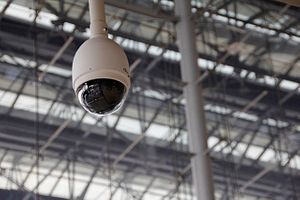China is taking the lead in drawing on recent technological developments to vastly enhance its capacities to keep its people under surveillance. In particular, it is deploying facial-recognition technology in places such as banks, hotels, stadiums, airports — and numerous street corners. The number of surveillance cameras in China, estimated at 200 million, is four times greater than the number of such cameras in the United States, according to a New York Times report. (However, given that China has four times more people than the U.S. the ratio per capita — the more appropriate measurement — is the same.)
The main violation of privacy is not that this technology is scanning faces of people not suspected of having committed any offense — they are in public spaces and even in democracies, “scanning” by the police, looking for suspects on the wanted list as well as others, is quite common. Rather, the main privacy-violating feature of the Chinese system is that it compares the faces that are scanned to those found in a database that includes the pictures of many millions of Chinese citizens — whether or not they committed a crime, or were merely arrested.
Until recently, privacy advocates could console themselves some by noting that facial-recognition technology was unreliable. It used to generate many false positives (misidentifying people as criminals or suspects) and false negatives (not catching offenders). It especially had difficulties in distinguishing people of dark pigmentation from each other. However, recent improvements in facial-recognition technology and advances in AI have made it much more reliable. Indeed, reports show that Chinese authorities have successfully used it to catch criminals mixed in a mass crowd at concerts, train stations, and at street intersections. Jaywalking (a source of traffic fatalities) is reported to have been significantly reduced, and in at least one instance, the New York Times reports, bicycle theft was eliminated at a building complex.
China is moving to integrate information from facial-recognition cameras with input from other surveillance technologies, further enhancing its capacity to surveil its people. Its “Sharp Eyes” project intends “to connect the security cameras that already scan roads, shopping malls and transport hubs with private cameras on compounds and buildings, and integrate them into one nationwide surveillance and data-sharing platform,” writes Simon Denyer in the Washington Post. He adds “At the back end, these efforts merge with a vast database of information on every citizen, a ‘Police Cloud’ that aims to scoop up such data as criminal and medical records, travel bookings, online purchase and even social media comments — and link it to everyone’s identity card and face.”
The first lesson one draws from these new technological developments is that the notion that the internet will provide a way to bring down tyranny needs to be updated, if not turned on its head. Much was made during the Arab Spring of the use of the internet by those who rose against their government. (Some reports later concluded that the role of the internet in these uprisings was overstated.) Regardless, now that one clearly sees that the internet can be used, at least as readily, to enhance massive surveillance, one must accept that it is far from the libertarian utopia its champions assumed it to be.
The second lesson is that totalitarian regimes are developing highly effective tools that allow them to oppress their people and stay in power with relatively little bloodshed. I am not saying that people in China are not jailed for political offenses, or simply disappear. However, at least for now, the authorities seem to have found ways to keep the lid on it without resorting to the kind of actions China took when it sent tanks to Tiananmen Square, and at least hundreds, and perhaps thousands, of protesters were shot in cold blood along the way. High tech totalitarian governments seem to be at least somewhat less heavy-handed and hence more able to maintain control.
One can be less alarmed by, and even find some value in, a new usage of facial-recognition technology by the Chinese authorities, namely for shaming. The New York Times reports that cameras with facial-recognition technology were installed at a busy intersection where jaywalking is a common occurrence. On a large outdoor screen, the photos, names, and government ID numbers of those caught jaywalking are displayed in an effort to publicly shame offenders. The result was a decrease in jaywalking at that intersection.
Many libertarians and liberals find shaming a very shameful way of keeping public order. However, this is the way social order has long worked in small communities. Most people, most of the time, “behaved” because their behavior was visible and their identity was known. When people moved into cities, they became anonymous and crime exploded, leading to high levels of incarceration. To the extent that one can now identify people in cities — as the Chinese data suggests — public order will be improved. Note that shaming is essentially democratic because if people do not believe the behavior highlighted is inappropriate, no shaming follows.
I realize, of course, that China is using this new technology to oppress people. But the fault is in the particular way this technology is being used rather than being inherent in it. Examples from China demonstrate that facial-recognition technology, and shaming — if used for proper purposes — can help save many lives and curb crime.
Amitai Etzioni is a University Professor and Professor of International Relations at The George Washington University. He is the author of Foreign Policy: Thinking Outside the Box. A short film summarizes his International Relations work.

































